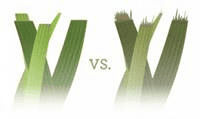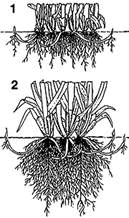How to Mow a Lawn – the right way
Believe it or not, the way a lawn is mowed can be the difference between a beautiful, thick, deep green lawn with very few weeds and a pretty ugly lawn. Grass is a living plant and it can easily be damaged by improper mowing. An improperly mowed lawn can greatly undo the benefits of fertilization, weed control, aeration and other efforts intended to create a beautiful lawn.
Mower Blade
The first thing to think about is the blade on your mower. You want to make sure the blade is sharp.
 A dull mower blade will rip and tear the grass instead of making a nice clean cut. When this happens, the lawn gets an off-color, brownish look to it – it actually looks like a lawn that is drying out. If you look closely, you will see that the tips of all the grass blades are brown and that makes the entire lawn look off-color.
A dull mower blade will rip and tear the grass instead of making a nice clean cut. When this happens, the lawn gets an off-color, brownish look to it – it actually looks like a lawn that is drying out. If you look closely, you will see that the tips of all the grass blades are brown and that makes the entire lawn look off-color.
Take a close look at the grass after you mow it – if it looks like the cut ends are frayed, it’s time to have the blade sharpened. It takes a few days for the brown look of the lawn to appear.
If you have a ‘typical’ quarter-acre suburban lawn, you can probably get away with only having the blade sharpened once or twice a year.
A good practice for homeowners that are only using their mower for about an hour each week is to have it serviced at the end of the season. Among other things, this service should include sharpening the blade. Then, in the July/August time period, it’s good to consider having the blade sharpened again to get you through the fall.
Grasscycling
We strongly recommend leaving your grass clippings on the lawn (don’t bag them). This is referred to as Grasscycling. Grasscycling has many benefits for your lawn and saves time. Click Here for more info on Grasscycling.
Mulching Mowers
A mulching mower will chop up the grass clippings into smaller sizes than a standard mower. This provides a couple nice benefits. First, the smaller pieces of grass clippings will decompose faster & return nutrients to the soil sooner. This is especially good when we are mowing grass that has gotten taller than it should. Also, since we can’t always mow when the grass is completely dry, we sometimes get clumping of the grass and a mulching mower will break-up these clumps better.
Mowing height – the most important part of mowing
 For a lawn to provide the features we want (thick, barefoot-friendly grass, minimal weeds and a nice deep green color) the grass needs to be healthy. For any plant to survive, it needs to produce food (photosynthesis). The grass blades are the leaf of the plant and, just like any tree or shrub, the leaf is where the food is made. If there is not enough leaf surface, the plant cannot produce enough food to remain healthy.
For a lawn to provide the features we want (thick, barefoot-friendly grass, minimal weeds and a nice deep green color) the grass needs to be healthy. For any plant to survive, it needs to produce food (photosynthesis). The grass blades are the leaf of the plant and, just like any tree or shrub, the leaf is where the food is made. If there is not enough leaf surface, the plant cannot produce enough food to remain healthy.
Therefore, if a lawn is mowed too short, the grass will starve. This leads to ugly lawns – thin, weedy, off color lawns that are very susceptible to other problems.
Turf grasses used in our area should be cut to minimum height of 2 ½” – 3”. Lawns that are mowed 3”- 4” high will most often have better color.
Mowing Height Determines Root Growth in Lawns
 There is a direct relation between mowing height and root mass development. In the top picture, you can see the shorter grass produces fewer and shallower roots then the grass cut higher. The higher mowed grass produced more and deeper roots which will help the grass during drought.
There is a direct relation between mowing height and root mass development. In the top picture, you can see the shorter grass produces fewer and shallower roots then the grass cut higher. The higher mowed grass produced more and deeper roots which will help the grass during drought.
But they cut grass short on golf courses…
Yes, but the grass used on golf greens is not the same as the grass we use on lawns. Golf courses use grasses such as bentgrass and Bermuda Grass which are creeping types of grass – meaning they grow low to the ground. This allows these types of grass to be mowed very short and also produce enough leaf surface to survive.
Mowing Frequency
If at all possible, try not to cut off more than 1/3 of the grass blade at one time. Often, once a week mowing is fine. However, in the spring when the soil is wet and warm, the grass might need to be mowed every five days to prevent shocking the plant. What you want to avoid is letting your grass get too tall and then cutting it short – for example, don’t let your grass get 6” tall and cut it down to 3”. Doing this will actually send you directly to lawn care hell – and no one wants that!
Don’t Mow Too Often in Hot, Dry Weather
On the other hand, if we get into a hot, dry period and the grass isn’t growing very much – don’t mow it. We know that mowing, especially in extreme heat, is everyone’s favorite activity – but try to resist the urge – your lawn will appreciate it! It is especially important to keep the grass tall in hot summer weather. Water makes up about 90% of a grass blade and, in hot conditions, the plant needs the water – so don’t cut it off. Taller grass also creates shade on the soil so, when it rains, you irrigate your lawn or even have morning dew, the water doesn’t evaporate as quickly.
“Team Effort between Mowing and Lawn Care Services”
If you or your mowing company follow the guidelines in this article, you will get the maximum value from your Green Giant Lawn Care Services. Please contact us we are happy to help in any way we can!

Lawn Care
Green Giant Home & Commercial’s Lawn Care services control weeds, build the thickness and density of your lawn and protect it from being damaged by insects and disease, providing you with a great-looking, healthy lawn. We offer fertilization, weed control, liming, insect control, and aeration and overseeding. Visit our Lawn Care page for more information.
Tree Care
Green Giant performs: Proper Diagnosis and Treatment of Tree & Shrub Problems, Insect & Disease Control (including Spotted Lanternfly), and Nutrient Management via Deep Root Fertilization to keep your plants healthy and thriving. Visit our Tree Care page for more information.
Vegetation Management
Green Giant’s Non-Lawn Weed Control services eliminate unwanted vegetation in a wide variety of locations for both residential and large commercial/municipal properties. Areas include fence lines, around obstacles to reduce weed eating, stone/gravel driveways & parking lots, swales, roadside/curbside vegetation management and more. Find more information, visit our Vegetation Management page.
Pest Control
Our full service pest control division provides both Year-Round Service Programs that cover the vast majority of pests that you will encounter and also One-Time Corrective Services for pests such as bees, ants, termites or mice. For more information, visit our Pest Control page.